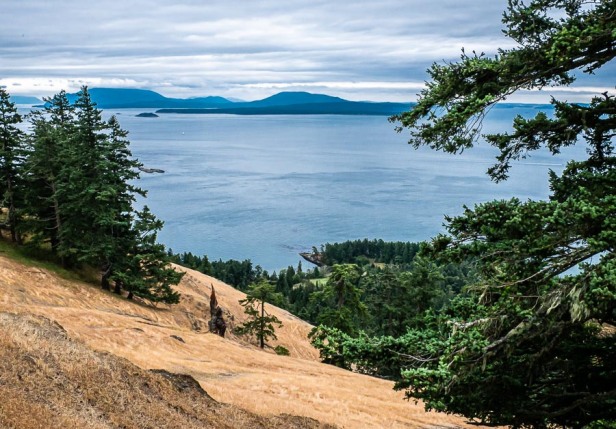
3-10 July 2019 Saturna Island, BC. We’d walked the nearly two kilometres in from the road, passed through the backcountry campsite, and found our way onto Echo Bay trail. Walking over the rocky ground knitted together with the dry brown grass of a hot summer, past the arbutus trees and the Douglas firs, we’re nearly at the edge of the cliff when suddenly I spot it silhouetted against the azure sea way below. It’s the rear end of a large adult male right on the edge of the cliff! We creep closer. There are three of them: Saturna Island’s famous feral goats.

They hear us, see us, smell us and are off down the cliff face, moving where only a goat can go, but still, it’s exciting to see them, and much closer than those we’d seen the previous day.
We’d arrived on Saturna Island a couple of days earlier by ferry from Vancouver Island. We’d been visiting a friend in Duncan on a weeklong amble around the islands and Saturna was our next stop. Saturna is the most easterly of the islands between Vancouver Island and the mainland and due to a kink in the offshore border it’s surrounded on three sides by the US. All the islands to the north of the border are called the Gulf Islands; all those to the south are known as the San Juan Islands, and they all lie in the Salish Sea. I love that name: the Salish Sea. It’s a “new” umbrella term for the colonial names of the area – the Georgia Strait, the Strait of Juan de Fuca, and Puget Sound. All lie within the Salish Sea, which recognises the original inhabitants – the Coast Salish peoples.
Leaving the ferry we drive a few hundred metres up the road to Arbutus Point Campground, the only campground with facilities on Saturna. We’ve booked a canvas wall tent. With beds! Luxury! We’re going glamping! Alas not quite. Because the tent has beds we assume there will be bedding. But no, just beds. Fortunately the lovely woman who checks us in loans us what we need. Also not really glamping: there is no power in our tent, the only outlet being at the facilities a couple of hundred metres across on the other side of the campground. We have a travel fridge that needs to be plugged in, and an electric kettle.
Each morning I gather all I need from our food box and wander over and plug in the kettle and make myself a cup of tea. It takes very little to make me happy; one of the most important things is a cup of tea first thing in the morning, and although the outlet is on the far side of the campground, and down low next to the boardwalk in front of the shower room so I have to squat down to get at it and make my tea on the ground, I am absurdly pleased with the way I’m able to make everything work. We have all we need to be comfortable and to provide ourselves with breakfast and lunch. Dinner we have at the pub just down the road by the ferry dock. I am so not a foodie. I don’t make notes of what we eat, or take any instagrammable photos, but we do enjoy the meals there.
Our tent may not have power but it does have a patio looking out over Lyall harbour,

and it’s a short walk down to the deck of the pub for a wide open view of the sunset.
This campground is nothing special: a composting toilet, a raised platform for outdoor cooking with a sink and hot water, a shower room, four tent sites with picnic tables, and two wall tents, all set in an inelegant mix of gravel and unkempt grass and a few straggly trees. But I am happy! We have all we need.
Over the next couple of days bit by bit I explore the area around the campground – down the hill to the nearby government dock,
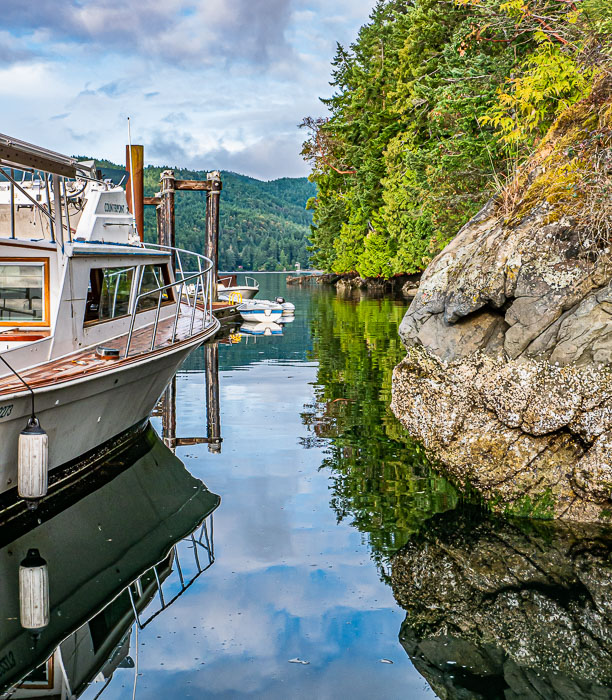
which allows me to get right down by the water below our tent,
and where hiding at water’s edge is a Great Blue Heron fishing for dinner.
And every night after dinner at the pub we watch the sunset from the patio as it gradually turns the sky and water from blue to golden,
and then to indigo with a splash of raspberry jam and honey.
Saturna is one of the least populated and least spoiled of the Gulf Islands. For all its proximity to Vancouver, the year-round population is only 350, and most of the island is part of the Gulf Islands National Park Reserve. It takes coordinating two fairly infrequent ferries to get there from Vancouver, and even then there can often be a stop along the way at another island. This means there’s not much there – the pub, a small café, the campground, a general store, and on the other side of the island the walk-in campground with a pit toilet but no fresh water. That’s about it really except for the beauty; the wild untouched forests; the natural silence punctuated by bird song and the wind in the trees; soaring eagles; wild goats and deer; the views across the water to the surrounding islands; one of the best places on earth to see migrating orcas from land; and heart-stopping sunsets. This small island, only 31 square kilometres in area, and only 10 kilometres in length, radiates solitude and tranquillity.
Our first exploration is to hike the Brown Ridge trail. Warburton Pike, the highest mountain on the island soars up on one side, with the infinite sapphire sea and sky framed by fir trees on the other.
The original track was a goat trail and in some parts it still is.
Brown Ridge is all dry grass and rocky bluffs, great views of the water and other nearby islands, and gnarled fir trees, some tall and leaning inland from the wild winter storms, some missing their tops, and some fallen altogether having lost the battle with the hurricane force winds. But this day is soft and calm and blue as we walk the three kilometres out and back again. And we see goats! It’s our first sighting of them, but of course they’re skittish and run quickly from us.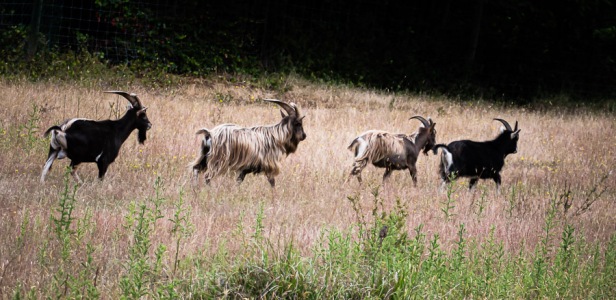
There are about 100 goats in the Brown Ridge tribe, and many more spread across the island. They originally came from a dairy herd that was abandoned back in the late 1800’s and they quickly adapted to the mild climate. Most of the Gulf Islands have herds of feral goats.
It’s the next morning that we walk the path into Narvaez Bay, pass through the backcountry campground, and spot the goats on the ridge. We walk the rocky ridge with forest on one side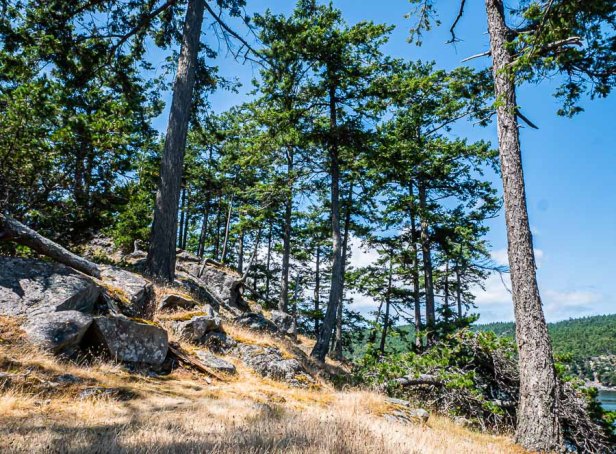
and glorious views of Boundary Pass on the other,
until at last we arrive at exquisite diminutive Echo Bay.
The further inland the water goes the more emerald it becomes, a shining secret jewel highlighted by the clamorous orange of the arbutus trees.
In the afternoon we head out to Winter Cove, a sheltered bay with open meadows backed by a forest of Douglas Fir.
We walk the easy 1.5 kilometre loop trail that takes us through the forest until eventually we reach the open water of Georgia Strait. Here the land is only forty metres from tiny Samuel Island, and the calm waters of the bay are in an endless battle with the deep waters of the strait creating an ever-restless race, glassy on one side and roiling on the other.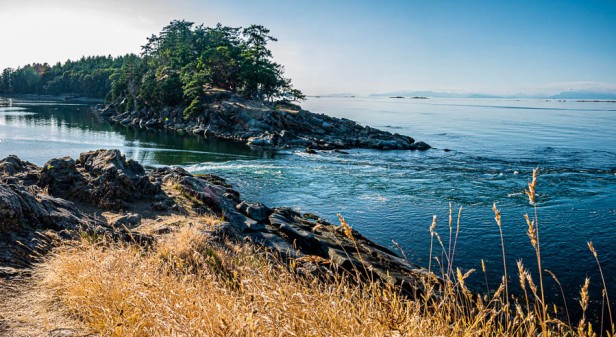
I’m fascinated with the way the water is moving, at war with itself, one side trying to get out but unable to win against the bigger opponent so that there is never any peace. Turning away from the warring waters and looking out across the strait it’s the opposite. In this direction there’s a blue dream of a view of Mount Baker, about a hundred kilometres away in Washington.
Walking back, first along the shore and then through the forest we see it! Our first sighting of one of the many Black-tailed Deer on Saturna, and it stays a moment to say a shy hello.
It’s so exciting to finally see one, though before we leave the island we see several more.
The next morning we say goodbye to our cosy home at the campground and head east as far as you can go along the northern shore of the island to stay with friends. We stop along the way to scramble down onto the rocky beach. Here there are wild flowers,

and strewn seaweed, fallen trees, their tangled roots reaching to the sky
and another fabulous view of Mount Baker.
It’s on the way to our friends’ house that we see more deer: a doe and fawn with all the cuteness of Bambi.

Our friends P and L had only recently started living on Saturna in a major lifestyle move – upsizing rather than downsizing like people our age are supposed to do. But they always have been intrepid so taking on a large property, a house that needs renovations, and plans for two art studios may be daunting to ordinary people but not to them. It’s so good to see them again.
Their home is among a small raggle-taggle cluster of houses at this far end of the island. After settling in we walk past the little cove
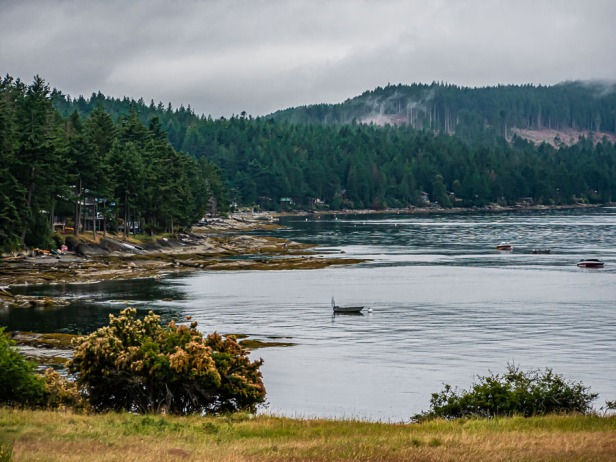
to East Point, the very most eastern part of the island, and one of the best places for whale watching, though P tells me they’ve already seen them from their front deck. What a place to live! We don’t see any whales but we do see a lone seal swimming off shore; and another deer sighting! I suddenly see this fine-looking young buck that carefully watches that we don’t come too close, then ambles away. I’m not blasé about them, and likely never will be, though no doubt people who live on the islands are.
For many years I lived in the far north of Canada in the tiny town of Atlin, and in various places in the Yukon. Come October, when moose hunting season opened, many families would hunt for a moose. Moose are enormous and can easily feed a family for a year. We would have moose butchering and wrapping parties, each cut wrapped and labelled and stored in the freezer. Nothing was wasted. It was a native tradition of course, but non-native people living in these remote places (even in the city of Whitehorse where groceries are expensive because they are all transported) followed their lead. I never actually shot a moose. I learned how to use a gun to protect myself from bears while cooking in remote wilderness camps but decided I was more scared of guns than I was of bears. Anyway back to Saturna and the Gulf islands: many people there, in the same way, hunt deer in the fall for meat to fill the freezer. It makes better sense to sell the more valuable livestock, and eat venison. And it keeps the numbers in check.
As we leave the area I look back and for a moment think I’ve stepped into an Andrew Wyeth painting.
This is the solitary building in the East Point area of the Gulf Islands National Park Reserve. It is the Fog Alarm Building, originally used exactly as its name suggests, but which is now a small museum.
Back at P and L’s place we explore their new home, the deer-proof garden of herbs and roses and great plans for the future, the art studio, and plans for another, and the wide expanse of lawn contained by forest on three sides and the Salish Sea on the fourth. We have drinks and appies sitting outside looking out over the sea and catch up, talking our way through the sumptuous dinner that P and L prepare for us, and on into the evening.
We’d planned to stay another day, another night, but next morning Don is suddenly unwell, his heart again, and we need to get back to Vancouver. There’s a photo of the four of us sitting in the pub where we had lunch together and waited for the ferry. We don’t look very happy. It was an abrupt end to our summer island ramblings. But I remember all the best things about Saturna Island: catching up with old friends – thank you so much P and L for your wonderful hospitality; the deer and goats – there is nothing quite as special as seeing wildlife in the wild; the warring waters at Winter Cove; our cosy campground home; the beautiful views; the trails and forests; and of course the sunsets.

PS: Don is fine. This trip happened in the summer of last year. He felt wonky for a few days, saw his cardiologist, and then things settled down. Settled down enough that we spent six weeks travelling in India and Malaysia earlier this year.
All words and images by Alison Louise Armstrong unless otherwise noted
© Alison Louise Armstrong and Adventures in Wonderland – a pilgrimage of the heart, 2010-2020.

Wow! That looks incredible! I would love to see it! Thanks for the recommendation! 😍😍
LikeLiked by 1 person
It’s really beautiful. I hope you have a chance to get to BC when you finally get to Canada.
Alison
LikeLiked by 1 person
I hope so too! I actually got here a month ago! But, we’ll see about a trip to BC because of COVID-19
LikeLiked by 1 person
Congratulations! Welcome to Canada!
A.
LikeLike
Thank you! I absolutely LOVE it here!! 😍😍
LikeLiked by 1 person
Incredible photos. What an amazing place. Thanks for sharing. Glad Don is okay now.
LikeLiked by 1 person
Thanks so much Donna. I’m glad you enjoyed it. The Gulf Islands are so beautiful. We’re lucky to live so close.
Alison
LikeLike
Oh the goats adorable…going to send it to my grandson…also sending all good things to you both 👌☺️🤗 hugs hedy
LikeLiked by 1 person
Thanks Hedy. I loved the goats too. Any the deer, and any wildlife really lol. Hope your grandson enjoys them.
Sending all good things to you too.
Alison
LikeLiked by 1 person
Lovely words to complement beautiful images. I read the pleasure of simple things, the watching of animals roaming freely in people’s surroundings, I read a peaceful harmony. Thanks for taking the time to share it.
LikeLiked by 2 people
Thank you so much. Oh yes – pleasure in simple things, joy of wildlife and nature, and tranquility. It was a lovely time.
Alison
LikeLiked by 1 person
What a wonderful collection of images and commentary! We love the Gulf Islands and did spend a few nites in a cabin on Saturna with our kids about 25 yrs ago. (Yikes!) And since I recently retired, we had considered buying a property on Gabriola, but felt that our kids and grandchildren were unlikely to visit us there, even though we could buy a nice house on a sandy beach for $800K. So we moved to Chilliwack instead – to a cute cottagey 70 yr old half duplex in an area called Garrison Crossing which was formerly housing for Canadian Forces Base families. It is quite a sweet little neighbourhood. You can google it to find out more.
LikeLiked by 1 person
Thanks so much Michael. We also love the Gulf Islands, and have visited quite a few of them over the years. This was our first trip to Saturna. I’ve been to Chilliwack a few times since my nephew used to live there, but he’s back in Vancouver now.
Alison
LikeLiked by 1 person
Saturna Island is so lovely. I recall visiting a few years ago and discovering an old school with some interesting history. I bought cards made by children, sold on the honour system as there was no one there to collect the money, just a box to put the money in. The deer and the goats are wonderful. Great pictures.
LikeLiked by 1 person
Thanks so much Darlene. I loved the deer and goats. Well any wildlife makes me sing inside. I’ve seen honour system setups in quite a few rural places in BC. I remember one place selling flowers. So lovely. So Canadian lol.
Alison
LikeLiked by 1 person
I sound like a broken record, but once again lovely descriptive writing and fab Fotos. Let’s hope the world rights itself somewhat and off you can go again, taking us with you.
Stay safe
Keith
LikeLiked by 1 person
Thanks so much Keith. It’s a broken record I can happily live with 🙂
The world is a bit tilted at the moment that’s for sure. I gather you had to head home. At least you got a little taste of your beloved France. We’re not going anywhere – probably not for a long time 😦 it’s just not safe enough. But it’s ok, we are content, and much blessed.
Alison
LikeLike
Oh, good – I was looking for that P.S.!
What an idyllic few days. Boy, do I need an escape like this right about now … a tent, some views, some wildlife! As usual, I love all your photos; the flora and fauna ones made me ooh and aah, but the one that stopped me in my tracks/scrolling was the Fog Alarm Building sitting there all bleak in its scrubby field. Perfection!
LikeLiked by 1 person
Thanks so much Lexie. That about sums it up – a tent, views, wildlife. It’s so nourishing. You should come visit when the world rights itself!
I love that I got that photo of the Fog Alarm Building. I looked back at just the right time.
Alison
LikeLiked by 1 person
Reading this post was just what I needed to start my morning. Peace, tranquility and beauty.
Thank you.
Be safe.
Steve
LikeLiked by 1 person
Thank you so much Steve. I’m glad you enjoyed it.
Cheers to you and Annie.
Stay safe
Alison
LikeLike
Thanks for the update on Don and the time frame. Glad to hear a relatively easy adjustment.
My Mom has a cousin on Saturna and she wrote on our blog about a fishing adventure they did together. I adored your photos, especially of the feral goats which I was not aware.
LikeLiked by 1 person
Thanks so much Sue. The goats were a great surprise! We loved our brief sightings of them. And yes, Don is fine now.
I’m off over to your place to find your mom’s story about Saturna!
Alison
LikeLiked by 1 person
Thanks Alison. Here’s her story https://traveltalesoflife.com/shirleys-travels-fish-story-saturna-island/
LikeLiked by 1 person
Oh I went over and read it already (and commented). What a story! Two fish in one. Shared the pic with Don as we figured out what fish ended where lol.
A.
LikeLike
Saturna looks so lovely, Alison! Tremendous photos of the feral goats. We haven’t made it there yet. I like the idea of staying in those canvas tents (what a view from your patio!). There are so many islands to explore in the Salish Sea and I love that many of them are quite distinctive in character and geography. We had a great time on Quadra Island this past summer. It’s also very laid-back and unspoiled. I’m glad you added that PS about Don!
LikeLiked by 1 person
Thanks so much Caroline. This was our first time on Saturna, and we’ve not been to Quadra – so many islands to explore! But I’ve never met a Salish Sea island that I didn’t love. So much beauty! And the wall tent was fabulous. Apparently the wall tents there now have power and as a result have doubled in price in the summer!
Don’s fine.
Alison
LikeLike
Reminded me of the week-long kayak trip Peggy and I took off of Vancouver Island a few years ago, Alison. It is beautiful! And your photos (as always) captured it well. The goat in the first photo looked like he was smiling! 🙂 –Curt
LikeLiked by 1 person
Thanks so much Curt. That goat *does* look like it’s smiling! I imagine that kayak trip was pretty fabulous. I’d love to do something like that – but only on calm water! (I’m fussy that way 🙂 )
Alison
LikeLike
The water during the kayak trip wasn’t bad, Alison. And we had excellent guides. Now dodging cruise ships was a little worrisome. 🙂 –Curt
LikeLiked by 1 person
That patio view is divine! Along with all your wandering across hills and into spectacular views. And the goats add to the charm with their rugged beauty. I, too, love the ring of the Salish Sea. From what you’ve shown, its specialness goes far beyond its name. Thanks for the escape!
LikeLiked by 1 person
You’re welcome. The Salish Sea is such a special place. We’ve been to a couple of the WA islands and a handful of the BC ones. Always lovely. Glad you liked the goats. Fun! (But not as fun as bison lol!) And we really enjoyed the campground even if it wasn’t high end glamping.
Alison
LikeLiked by 1 person
Fantastic photos! what a gorgeous place to explore
LikeLiked by 1 person
Thanks Sinjana. We’re so lucky to be able to explore this gorgeous part of the world.
Alison
LikeLike
Exquisite photography. Thanks for the tour.
LikeLiked by 1 person
Thanks so much V.J. I’m glad you enjoyed it.
Alison
LikeLiked by 1 person
Welcome.
LikeLiked by 1 person
What paradise. Not easy to get to, but so worth the effort, I imagine. Very sorry to hear that Don was unwell for the end of your trip. Being in a remote area can be challenging when you’ve got health issues.
LikeLiked by 1 person
It was definitely worth the effort, and a little easier for us since we were coming from Vancouver Island which cuts the trip in half. Mostly Don’s fine. We still don’t know what that was about. Just some random weird thing, but definitely these days we’re a bit more vigilant about where we go, and the availability of good medical treatment when we get there.
Alison
LikeLiked by 1 person
Ahhhhh. These updates about the Salish Sea islands are food for the soul. How I long to sit at a pub and watch a sunset! Especially the ones you included (and the dozens you didn’t!) in this post. A delightful way to spend a Saturday morning. 🙂
LikeLiked by 1 person
Thanks so much Felicity. So glad you enjoyed this little wander to the west coast. I think sitting at a pub watching the sunset is one of the great miracles of life. Wishing you many pub sunsets in your future!
Alison
LikeLike
Nothing special, she says! With views like that, who needs luxury? 🙂 🙂
LikeLiked by 1 person
I agree entirely! Views over luxury any time! You and I are both so very blessed that views are not a luxury. This makes me a little sad for all those people who don’t have views. Everyone should have views!
Alison
LikeLike
As I have never been to Canada I always love to read about destinations for the future and with all the wildlife and nature this one certainly hits the spot. I was sad to hear Don had taken a turn and then read your postscript that he was actually ok, thank goodness.
LikeLiked by 1 person
Thanks so much Angie. I’m glad you enjoyed this wander to Canada’s west coast. It’s a pretty special place that’s for sure. It’s all wildlife and nature all the time out here. Well, and a few great cities as well.
I just knew I had to put that PS about Don in there as I didn’t want people to be worried.
Alison
LikeLike
What a great post – lovely to have the images of your clamping experience now. 🙂 I paddled into Echo Bay this summer and sailed to East Point 13 years ago with a friend – very fond memories. Saturna truly is a gem, especially from the water where you get to see all the wonderful natural sandstone art. Big hug xox
LikeLiked by 1 person
Thanks Surati. We so enjoyed our glamping experience. Cosy and fun. Isn’t Echo Bay a gem! I loved it, and can imagine paddling in there would be pretty special. Where did you paddle from? I’m always so impressed and jealous of your kayaking expeditions, but not enough I guess to actually get out and do it myself lol.
Alison
LikeLiked by 1 person
Haha, yes, I think you would enjoy it though once on the water. And it’s really not that hard – would I do it otherwise?! We paddled from South Pender. I posted photos on FB in August I think. The rock formations are stunning! As is the water and kelp forests particularly in this area because of deep ocean water flow. And the water is cold! xo
LikeLiked by 1 person
I have kayaked before (Ha Long Bay with Ruth in Vietnam, and on a calm river in Laos are standouts) but we’re here all summer with many calm days and I easily could have gone down to False Creek and rented a kayak to tootle around there, but just didn’t. It’s the thinking about it, and knowing I’d enjoy it, but not actually doing anything about it that’s a bit frustrating. But only a bit apparently 🙂
xo
LikeLiked by 1 person
Haha – Have you been in the good comfy Kayaks we have in Vancouver? What I remember from SE Asia is rather bare bones and hard plastic. I dare you to explore – maybe with me in Cow Bay or on the river next summer? xo
LikeLiked by 1 person
I would love that! Don can hangout at the pub or s’thing lol.
A.
LikeLike
Would he dare getting in a double?
LikeLiked by 1 person
Oh yes of course – we were in doubles in Vietnam and Laos, but it would have to be calm (well, for me too). I was kind of joking.
A.
LikeLiked by 1 person
Oh my, how beautiful! I could sit on your non-glamping patio for hours just watching the world go by. Your words and stunning photos transported me to Saturna. Thank you for this inspiring armchair travel moment.
LikeLiked by 1 person
Thank you so much Jen, my pleasure. It’s such a beautiful place, and I must admit our non-glamping patio was pretty special. Now glamping! That’s your place on your recent safari!
Alison
LikeLike
This is just the thing on a cold, gray November day, a shot in the arm! It’s fun to make comparisons – we don’t have goats, no siree! But we have plenty of deer, views of Mt. Baker and most of the same plants. The 9th & 10th (cliff & heron) photos look very familiar. The water looks so pretty and refreshing in all your photos and those wildflower shots are beautiful!
LikeLiked by 1 person
Thanks so much Lynn. Those goats were so fabulous. We knew they were there, but to actually see them was really exciting. And the deer too. I’m always somehow shredded, in a good way, by seeing wildlife in the wild. I’m glad you enjoyed our trip to Saturna.
Alison
LikeLike
I am glad and relieved to understand Don is doing good. Saturna was on my list of places to visit this Summer, but I never got around to it. Thanks to you Alison, I feel I have been there. Amazing photography <3.
It makes me want to go there even more.
LikeLiked by 1 person
Thank you so much Anyes. It really was a lovely place to explore. I hope you get there one day! Definitely worth it.
Alison
LikeLiked by 1 person
Fingers crossed maybe next Summer. Thank you so much Alison
LikeLiked by 1 person
I love this article, Alison. BC’s Gulf Islands have my heart. I haven’t been to Saturna but you paint such an intimate picture of its tranquility and rustic beauty, I’m going to add it to my list!
The photos transport me immediately to the west coast.
LikeLiked by 1 person
Thanks so much Alison. Saturna is really lovely, and definitely worth a visit – when we can do such things again. I feel so lucky to live on the west coast, but the Okanagan is one of my fave places too. We’ve spent many a summer in Vernon or Kelowna. Have just subscribed to your blog to hear more about Paris!
Alison
LikeLike
This place looks so incredible! The sunsets!! The wildlife!!! Sounds like a charmed and delightful few days.
LikeLiked by 1 person
It’s a beautiful place. Charmed and delightful few days exactly sums it up. It was such a special time. Can’t wait for summer again!
Alison
LikeLiked by 1 person
Hello Alison – just stumbled on your post while looking for images of feral goats on Saturna. Your photos are absolutely stunning! I live here and see this beauty every day – and still your pictures took my breath away. Thanks so much for sharing – I look forward to visiting other places through your eyes.
LikeLiked by 1 person
Thank you so much Anne. 🙏 It was such a pleasure to visit Saturna, and to photograph all that beauty. I hope we get back one day. We loved it.
Lovely to “meet” you.
Alison
LikeLike
We just got home from a 3-day stay on Galiano island and are now obsessed with the idea of relocating to the gulf islands! Saturna looks wonderful and top of our list for our next gulf islands adventure, thanks for sharing! Wonderfully written, I really enjoyed reading and viewing your photos, thanks for sharing 🙂
LikeLiked by 1 person
Thank you so much Jacqueline. Saturna is really lovely, we enjoyed the beauty and quiet there. It’s so peaceful. Have a great time on your adventure there, and good luck with your planned move to the islands. We’ve spent time on quite a few of the Gulf Islands over the years, and really enjoy them.
Alison
PS I edited your comment for you: not to now
LikeLike